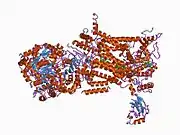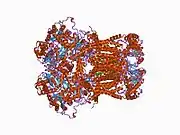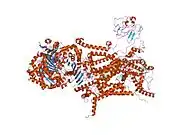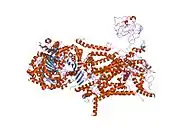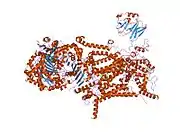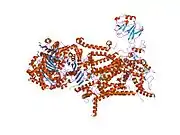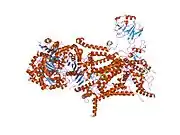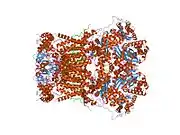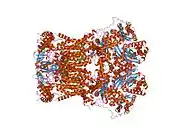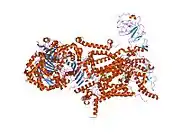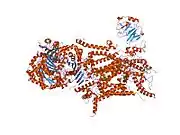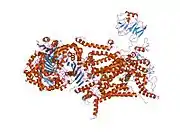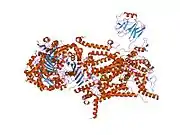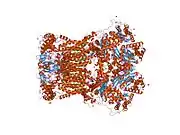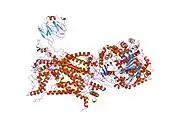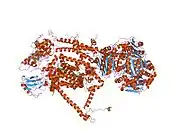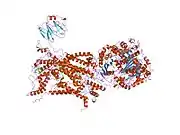UQCRH
Cytochrome b-c1 complex subunit 6, mitochondrial is a protein that in humans is encoded by the UQCRH gene.[4][5]
| UQCRH | |||||||||||||||||||||||||
|---|---|---|---|---|---|---|---|---|---|---|---|---|---|---|---|---|---|---|---|---|---|---|---|---|---|
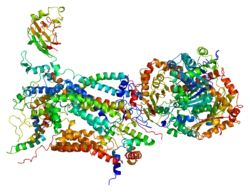 | |||||||||||||||||||||||||
| Identifiers | |||||||||||||||||||||||||
| Aliases | UQCRH, QCR6, UQCR8, ubiquinol-cytochrome c reductase hinge protein | ||||||||||||||||||||||||
| External IDs | OMIM: 613844 MGI: 3641869 HomoloGene: 103848 GeneCards: UQCRH | ||||||||||||||||||||||||
| |||||||||||||||||||||||||
| Orthologs | |||||||||||||||||||||||||
| Species | Human | Mouse | |||||||||||||||||||||||
| Entrez | |||||||||||||||||||||||||
| Ensembl | |||||||||||||||||||||||||
| UniProt |
| ||||||||||||||||||||||||
| RefSeq (mRNA) |
| ||||||||||||||||||||||||
| RefSeq (protein) |
| ||||||||||||||||||||||||
| Location (UCSC) | Chr 1: 46.3 – 46.32 Mb | n/a | |||||||||||||||||||||||
| PubMed search | [2] | [3] | |||||||||||||||||||||||
| Wikidata | |||||||||||||||||||||||||
| |||||||||||||||||||||||||
Its gene product is a subunit of the respiratory chain protein Ubiquinol Cytochrome c Reductase (UQCR, Complex III or Cytochrome bc1 complex; E.C. 1.10.2.2), which consists of the products of one mitochondrially encoded gene, MTCYTB (mitochondrial cytochrome b) and ten nuclear genes: UQCRC1, UQCRC2, Cytochrome c1, UQCRFS1 (Rieske protein), UQCRB, "11kDa protein", UQCRH (cyt c1 Hinge protein), Rieske Protein presequence, "cyt. c1 associated protein", and "Rieske-associated protein".
References
- GRCh38: Ensembl release 89: ENSG00000173660 - Ensembl, May 2017
- "Human PubMed Reference:". National Center for Biotechnology Information, U.S. National Library of Medicine.
- "Mouse PubMed Reference:". National Center for Biotechnology Information, U.S. National Library of Medicine.
- Ohta S, Goto K, Arai H, Kagawa Y (Jan 1988). "An extremely acidic amino-terminal presequence of the precursor for the human mitochondrial hinge protein". FEBS Lett. 226 (1): 171–5. doi:10.1016/0014-5793(87)80573-2. PMID 2826252.
- "Entrez Gene: UQCRH ubiquinol-cytochrome c reductase hinge protein".
Further reading
- Liu AY, Bradner RC (1993). "Elevated expression of the human mitochondrial hinge protein gene in cancer". Cancer Res. 53 (11): 2460–5. PMID 7684318.
- Kato S, Sekine S, Oh SW, et al. (1995). "Construction of a human full-length cDNA bank". Gene. 150 (2): 243–50. doi:10.1016/0378-1119(94)90433-2. PMID 7821789.
- Strausberg RL, Feingold EA, Grouse LH, et al. (2003). "Generation and initial analysis of more than 15,000 full-length human and mouse cDNA sequences". Proc. Natl. Acad. Sci. U.S.A. 99 (26): 16899–903. doi:10.1073/pnas.242603899. PMC 139241. PMID 12477932.
- Modena P, Testi MA, Facchinetti F, et al. (2003). "UQCRH gene encoding mitochondrial Hinge protein is interrupted by a translocation in a soft-tissue sarcoma and epigenetically inactivated in some cancer cell lines". Oncogene. 22 (29): 4586–93. doi:10.1038/sj.onc.1206472. PMID 12881716.
- Gerhard DS, Wagner L, Feingold EA, et al. (2004). "The Status, Quality, and Expansion of the NIH Full-Length cDNA Project: The Mammalian Gene Collection (MGC)". Genome Res. 14 (10B): 2121–7. doi:10.1101/gr.2596504. PMC 528928. PMID 15489334.
- Wen JJ, Garg N (2005). "Oxidative modification of mitochondrial respiratory complexes in response to the stress of Trypanosoma cruzi infection". Free Radic. Biol. Med. 37 (12): 2072–81. doi:10.1016/j.freeradbiomed.2004.09.011. PMID 15544925.
- Gregory SG, Barlow KF, McLay KE, et al. (2006). "The DNA sequence and biological annotation of human chromosome 1". Nature. 441 (7091): 315–21. doi:10.1038/nature04727. PMID 16710414.
- Olsen JV, Blagoev B, Gnad F, et al. (2006). "Global, in vivo, and site-specific phosphorylation dynamics in signaling networks". Cell. 127 (3): 635–48. doi:10.1016/j.cell.2006.09.026. PMID 17081983.
This article is issued from Wikipedia. The text is licensed under Creative Commons - Attribution - Sharealike. Additional terms may apply for the media files.



